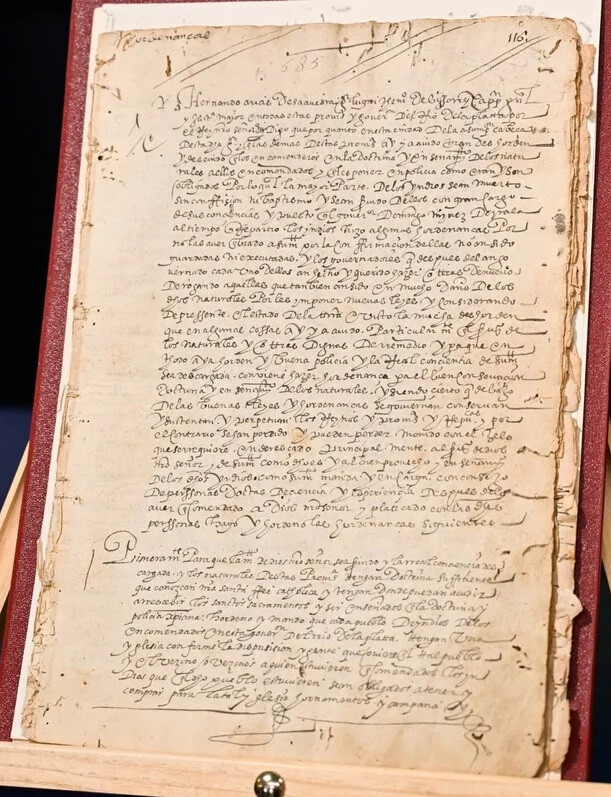
New York, NY – A significant piece of Paraguayan colonial history, a 13-page manuscript dating back to 1598, is slated to return to its rightful home after being discovered in the possession of a rare book dealer on Manhattan’s Upper West Side. The recovery, announced by Manhattan District Attorney Alvin Bragg, marks a victory for Paraguay’s efforts to reclaim its stolen cultural heritage.
The invaluable document, valued at approximately $20,000, had been a treasured holding of the National Archive of Paraguay in Asunción since 1870. More than a decade ago, it was pilfered from the archives, embarking on a clandestine journey that ultimately led it to the bustling rare book market of New York City.
The manuscript’s significance lies in its detailed account of the laws governing the daily lives of the Indigenous population within the Spanish colony. Penned and signed by the colonial governor of the time, Hernando Arias de Saavedra, the 1598 decree is considered a crucial historical precursor to the 1603 ban on the punitive encomienda system. This exploitative feudal system subjected Indigenous people to forced, unpaid labor for the Spanish colonists, making the manuscript a vital primary source for understanding the early colonial administration and its impact on the native inhabitants of Paraguay.
The recovery of the historical artifact was initiated in January following a crucial tip-off from the consul general of Paraguay in New York to the Manhattan District Attorney’s Antiquities Trafficking Unit. The unit, dedicated to recovering and repatriating stolen cultural treasures, swiftly launched an investigation that led them to the Upper West Side rare book dealer.
District Attorney Bragg expressed his satisfaction in facilitating the manuscript’s return. “We are thrilled to see this important piece of Paraguayan history returned to the people of Paraguay,” he stated, underscoring the importance of international cooperation in preserving cultural heritage.
Paraguay’s Consul General in New York, Fabiola Torres Figueredo, hailed the recovery as a symbol of the strong relationship between the two nations. “The return of this historical manuscript is a meaningful gesture of friendship and respect between our nations,” she affirmed. “It symbolizes our shared commitment to the preservation of cultural heritage and historical memory.”
Investigations revealed that after its theft from the Paraguayan National Archives, the manuscript resurfaced in 2013 at a Manhattan auction house. There, it was acquired by Martayan Lan Inc., a well-regarded dealer specializing in rare books and antique maps. As recently as Friday, the manuscript was listed for sale on the dealer’s website for $18,500, with a description noting “some wormholes and fraying to the margins, but perfectly legible.”
Seyla Martayan, contacted by the District Attorney’s office earlier this year, expressed her surprise at the situation. “No dealer wants to work with stolen material,” she asserted, highlighting her company’s 40-year history and reputation in the rare book trade. Martayan placed blame on Swann Auction Galleries, the Manhattan-based auction house from which she said her company purchased the manuscript, alleging a lack of transparency regarding its provenance.
While a call to Swann Auction Galleries for comment was not immediately returned, their website retains a record of the October 10, 2013 auction listing the manuscript. The listing, titled “Important decree concerning the rights of Indians,” specified the origin as “Asunción, 12 December 1598” and noted a hammer price of $9,500, exceeding the estimated value of $5,000 to $7,000. Swann Auction Galleries describes itself as “the largest auctioneer of Works on Paper in the world, and New York’s oldest specialty auction house.”
The Manhattan District Attorney’s Antiquities Trafficking Unit has a notable track record in recovering stolen cultural artifacts. Since its inception, the unit has successfully recovered over 6,000 antiquities and facilitated the return of nearly 5,500 items to 30 countries.
Erin Thompson, a professor of art crime at the John Jay College of Criminal Justice, commented on the broader issue of missing historical manuscripts. “Many historical manuscripts go missing from libraries and archives and then end up purchased by private collectors,” she explained. She further emphasized New York City’s central role in the global art market, making it a potential hub for the trade of illicit cultural property.
Thompson noted that increased digitization and publicity surrounding repatriation efforts are making it more challenging for buyers to claim ignorance about the problematic provenance of certain items. “More things are being spotted and more publicity is being given to returns, so I think more and more people who are buying can no longer say, ‘Oh, I didn’t know this was a problem,’” she stated. “So both dealers and collectors are increasingly responsible for making sure that what they’re buying is okay.”
The impending return of the 1598 manuscript to Paraguay underscores the ongoing efforts to combat the trafficking of cultural heritage and the importance of vigilance within the art and antiquities market. The recovery serves as a testament to the collaborative work of law enforcement and international entities in preserving and restoring historical treasures to their nations of origin.
[Copyright (c) Global Economic Times. All Rights Reserved.]




























